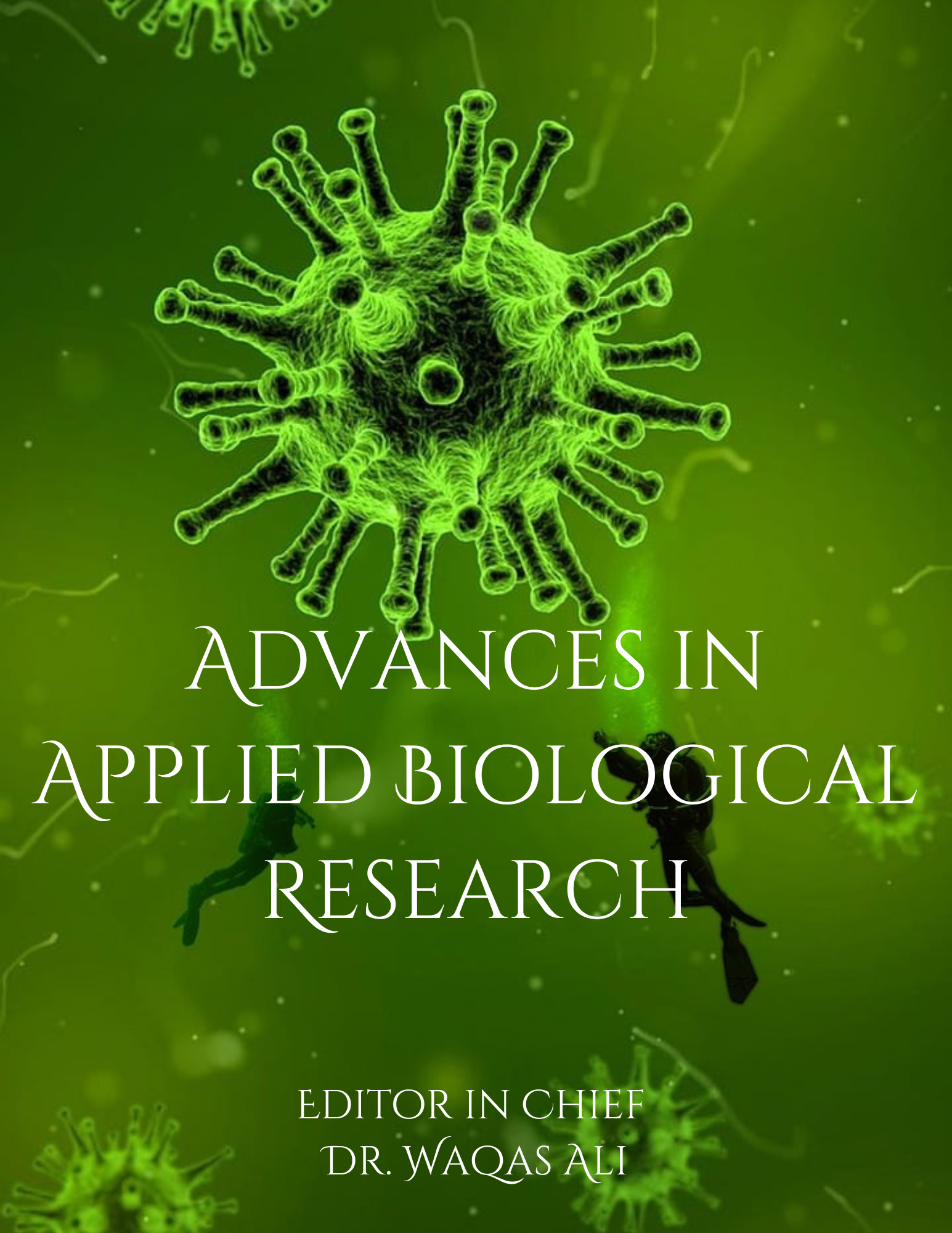Pharmacophore Generation and Structure-Based Strategies For Nnrti Development Against HIV-1 Rt
DOI:
https://doi.org/10.48165/aabr.2024.1.02Keywords:
HIV-1 RT, Pharmacophore, NNRTI, Molecular docking, Autodock, ZINC000014171386Abstract
The development of Non-Nucleoside Reverse Transcriptase Inhibitors (NNRTIs) is critical in combating HIV-1 due to the virus’s high mutation rate and resistance to current therapies. This study aims to identify potential NNRTIs through pharmacophore generation and structure-based drug design, focusing on the interaction of candidate molecules with HIV-1 Reverse Transcriptase (RT). Using molecular docking, three ligands, ZINC000002416705, ZINC000002416703, and ZINC000014171386, were analyzed for their binding affinity, inhibition constants, and interactions with key active site residues. The need for this study arises from the ongoing challenge of drug resistance in HIV treatment. To identify and evaluate potential NNRTIs against HIV-1 RT using structure-based pharmacophore modeling and molecular docking. HIV-1 RT was prepared by removing non-essential molecules, and ligand structures were retrieved and optimized. Molecular docking was performed using AutoDock, and interactions were analyzed using Biovia Discovery Studio. ZINC000002416705 exhibited the highest binding affinity (-8.66 kcal/mol) with significant hydrophobic interactions, though it lacked interaction with critical active site residues. ZINC000002416703 showed strong binding (-7.77 kcal/mol) and lower inhibition constant but no hydrogen bonding. ZINC000014171386, with a binding energy of -7.19 kcal/mol, directly interacted with key residues Lys101, Val106, and Cys181, demonstrating a potential as an effective NNRTI. ZINC000014171386 emerged as a promising NNRTI candidate, with binding characteristics comparable to the standard drug Nevirapine, warranting further investigation and optimization.
References
Battini L., Bollini M. Challenges and approaches in the discov ery of human immunodeficiency virus type-1 non-nu cleoside reverse transcriptase inhibitors. Med. Res. Rev. 2019;39:1235–1273.
Brechtl JR, Breitbart W, Galietta M, Krivo S, Rosenfeld B. (2001) The use of highly active antiretroviral therapy (HAART) in patients with advanced HIV infection: impact on medical, palliative care, and quality of life outcomes. J Pain Symptom Manag 21(1): 41–51.
Caballero, J. (2010). 3D-QSAR (CoMFA and CoMSIA) and pharmacophore (GALAHAD) studies on the differential inhibition of aldose reductase by flavonoid compounds. J. Mol. Graph. Model. 29, 363–371.
Cung, S.; Himmel, D. M.; Jiang, J. K.; Wojtak, K.; Bauman, J. D.; Rausch, J. W.; Wilson, J. A.; Beutler, J. A.; Thomas, C. J.; Arnold, E.; Le Grice, S. F., Synthesis, activity, and struc tural analysis of novel alpha-hydroxytropoloneinhibitors of human immunodeficiency virus reverse transcriptase-asso ciated ribonuclease H. J. Med. Chem.2011, 54 (13), 4462- 4473.
Gao, Y., Chen, Y. M., Tian, Y. F., Zhao, Y. L., Wu, F. S., Luo, X. G., et al. (2019). In silico study of 3-hydroxypyrimidine-2,4-di ones as inhibitors of HIV RT-associated RNase H using molecular docking, molecular dynamics, 3D-QSAR, and pharmacophore models. New J. Chem. 43, 17004–170017
Gujjeti, R. P., & Mamidala, E. (2013). Phytochemical analysis and TLC profile of Madhuca indica inner bark plant extract. Inter J of Sci & Engin Res, 4(10), 1507-1510.
Irwin JJ, Shoichet BK. ZINC--a free database of commercially available compounds for virtual screening. J Chem Inf Model. 2005 Jan-Feb;45(1):177-82.
Jocelyn Sunseri, David Ryan Koes, Pharmit: interactive explora tion of chemical space, Nucleic Acids Research, Volume 44, Issue W1, 8 July 2016, 442–448.
Koes D.R., Camacho C.J. ZINCPharmer: pharmacophore search of the ZINC database. Nucleic Acids Res. 2012;40: 409–414. Lansdon, E. B.; Brendza, K. M.; Hung, M.; Wang,R.; Mukund, S.; Jin, D.; Birkus, G.; Kutty, N.; Liu, X., Crystal structures of
HIV-1 reverse transcriptase with etravirine (TMC125) and rilpivirine (TMC278): implications for drug design. J. Med. Chem. 2010,53 (10), 4295-4299.
Leach A.R., Gillet V.J., Lewis R.A., Taylor R. Three-dimensional pharmacophore methods in drug discovery. J. Med. Chem. 2010;53:539–558.
Mamidala, E., Paindla, P., & Vijayagiri, R. C. (2013). Ethnobotanical survey in different mandals of Adilabad district, Andhra Pradesh, India. Int J Sci, 2, 77-83.
Martín-Alonso S., Kang D.W., Martínez Del Río J., Luczkowiak J., Frutos-Beltrán E., Zhang L.N., Cheng X.Q., Liu X.Y., Zhan P., Menéndez-Arias L. Novel RNase H inhibi tors blocking RNA-directed strand displacement DNA synthesis by HIV-1 reverse transcriptase. J. Mol. Biol. 2022;434:167507.
Morris GM, Huey R, Lindstrom W. et al. (2009) AutoDock4 and AutoDockTools4: automated docking with selective recep tor flexibility. J Comput Chem 30(16): 2785–2791.
Paindla, P., Mamidala, E., 2014. Phytochemical and chromato graphic studies in the leaves extract of Acalypha indica. Online Int. Interdiscip. Res. J. 4, 175–182.
Ren, J.; Esnouf, R.; Garman, E.; Somers, D.; Ros s, C.; Kirby, I.; Keeling, J.; Darby, G.; Jones, Y.; Stuart, D.; et al., High res olution structures of HIV-1 RT from four RT-inhibitor complexes. Nat. Struct. Biol. 1995,2 (4), 293-302.
Singh AK, Kumar A, Arora S, Kumar R, Verma A, Khalilullah H, Jaremko M, Emwas AH, Kumar P. Current insights and molecular docking studies of HIV-1 reverse transcriptase inhibitors. Chem Biol Drug Des. 2024 Jan;103(1):e14372.
Smerdon, S. J.; Jager, J.; Wang, J.; Kohlstaedt, L. A.; Chirino, A. J.; Friedman, J. M.; Rice, P. A.; Steitz, T. A., Structure of the binding site for nonnucleoside inhibitors of the rever setranscriptase of human immunodeficiency virus type 1. Proc. Natl. Acad. Sci. U. S. A. 1994,91(9), 3911-3915.
UNAIDS. Global HIV and AIDS Statistics- Fact sheet. Available at: https://www.unaids.org/en/resources/fact-sheet Vanangamudi M., Kurup S., Namasivayam V. Non-nucleoside reverse transcriptase inhibitors (NNRTIs): A brief overview of clinically approved drugs and combination regimens. Curr. Opin. Pharmacol. 2020;54:179–187.

